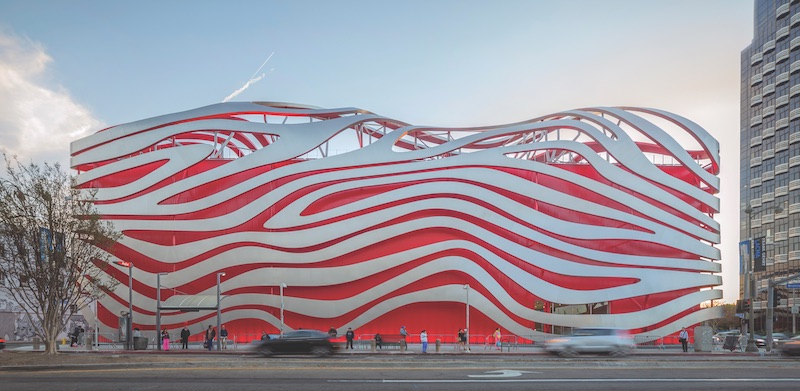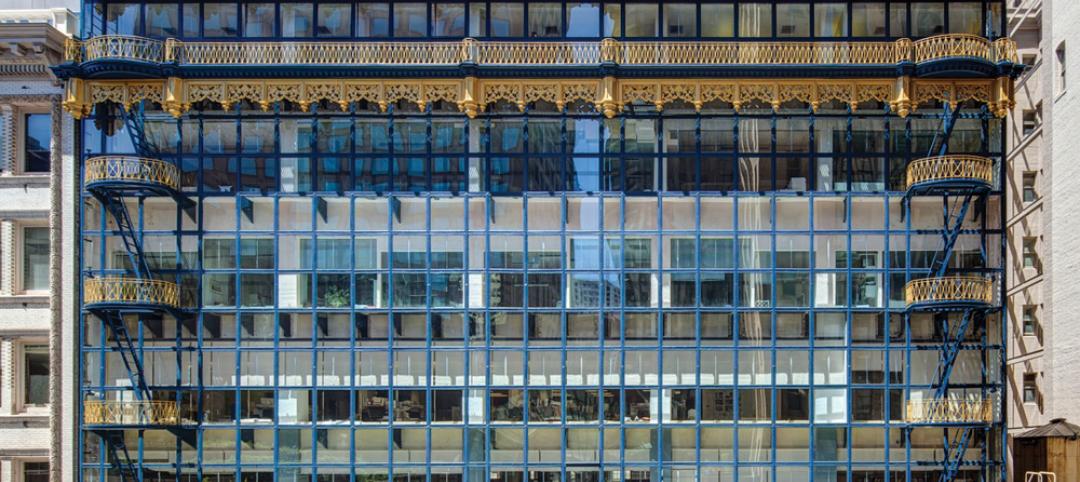Bill Kreysler doesn’t pursue projects that are “flat.” His company, Kreysler & Associates, is one of a small band of curtain wall designers, engineers, and fabricators that provides AEC clients the wherewithal to execute complex—some previously unthinkable—façade geometries.
Prominent examples of their work include the sweeping postmodern structures imagined by Frank Gehry, skeletal-like structures fancied by Santiago Calatrava, and the rippled exterior panels on the addition to the Snøhetta-designed San Francisco Museum of Modern Art (SFMOMA).
These façade experts—Kreysler, Enclos, and A. Zahner—have positioned themselves as artisans that can turn just about any vision into reality.
“One of the biggest problems for architects is general contractors and owners saying no to complexity,” says Gary Davis, Director of Marketing for Zahner in Kansas City, Mo. “We focus on rationalizing the models so they are doable.”
Enclos views itself as the middleman between the designer and the contractor to get projects to the point where they are buildable. Its recent work includes two New York City projects: the controversial Santiago Calatrava–designed World Trade Center transit hub, with its massive oculus pavilion and winged-dove contour; and the pyramid-shaped Via 57 West residential building, designed by Bjarke Ingels Group.
“Our job is often to introduce ‘constraints’ that make things constructable, but we’ll move as far forward as the design team lets us,” says Jeff Vaglio, PhD, PE, AIA, LEED AP BD+C, Vice President of Enclos’s Advanced Technology Studio, in Los Angeles. This intramural think tank is staffed with a multidisciplinary team of architects, designers, engineers, programmers, and visualization specialists.
Vaglio says Enclos has found the design-assist delivery model to its liking, with the stipulation that “if we can meet a budget, we can build it. We’re not interested in being a design service; we’re builders.”
 The San Francisco Museum of Modern Art expansion. Façade fabricated by Snøhetta, Kreysler, and Enclos.
The San Francisco Museum of Modern Art expansion. Façade fabricated by Snøhetta, Kreysler, and Enclos.
key factors: Schedules and funding
To be a leader in complex façade design and fabrication means staying at the leading edge of technology. Kreysler & Associates built its first CNC milling machine in 1985 to create large-scale sculptures based on 3D laser scans. (The artist Claes Oldenburg was one of their earliest clients.)
Zahner has nine patents and five others pending. These include its Zahner Engineered Profiled Panel System (ZEPPS) for the construction of curvilinear and other complex façade systems. “Our goal is to produce museum-quality edges in our work,” says Davis.
Enclos was experimenting with 3D printing as early as 2009. “We use it to model full-scale details of key connections, as well as to scale whole building models for our construction crews to visualize access for installation, maintenance, and replacement,” says Vaglio. “These are great communication pieces. Seeing a detail in a model is priceless and eliminates any confusion that might arise. And we can test fit the function of aluminum parts, since the 3D printer’s tolerance is nearly identical to that of the aluminum extrusion process.”
Enclos focuses on the process of creating shapes its clients want. Some concerns that complex façades present, says Vaglio, include:
- Warpage, which can occur when a complex surface geometry is subdivided into panels or modules.
- Moldability of the material being used.
- Variability, as in how much repetition is in the building envelope so that every panel doesn’t need to be reinvented.
These factors will add time and cost to a project. “But what’s not changing are the schedules we’re being held to,” Vaglio quips.
Realistic scheduling and sufficient budgeting are factors that Zahner considers, too, before diving into any assignment. The complexity of a project’s exterior design is much less of an obstacle these days, says Davis, because of the sophistication of available modeling software.
Zahner uses metal for all of its work. The fabricator eschews composites, partly because they aren’t recyclable. Davis points to two recent projects whose complex façades stand out:
- The 135,000-sf Petersen Automotive Museum, Los Angeles, which underwent a $125 million renovation in 2015. Its design, by Kohn Pedersen Fox, features a stainless steel ribbon assembly made from 100 tons of 14-gauge steel in 308 sections, 25 supports, and 140,000 custom stainless steel screws. Davis notes that every façade piece is unique, and none of the pieces touches the ground. Zahner employed several of its patented technologies on this project, among them Angel Hair Surface, which softens the reflexivity of stainless steel finishes, and ImageWall, which creates custom-perforated metal imagery.
- The River at Grace Farms, New Canaan, Conn., a single undulating aluminum roof that unites a sanctuary, library, court, commons, and pavilion. Zahner worked with Sanaa, a Tokyo-based architect with a reputation for bold, complex design, and Handel Architects. The result, says Davis, “is almost a surreal element” on the site.
Kreysler & Associates is something of a outlier, as it uses composites exclusively for complex façades it fabricates at its 30,000-sf shop in American Canyon, Calif. Kreysler says he became acquainted with composites while working for a boat-building company. When he started his own business, his first jobs were sets for operas and films. One of his first construction-related projects was making a composite replica of a building ornament that originally was made from terra cotta.
 BIG-designed Via 57 West, New York; façade fabricated by Enclos. Photo: © Tom Dobbins / Enclos.
BIG-designed Via 57 West, New York; façade fabricated by Enclos. Photo: © Tom Dobbins / Enclos.
composites vs. metals vs. concrete: finding the right material for the job
Kreysler prefers composites to metal, which he asserts can’t be formed into complex shapes. He likes composites for their flexibility, strength, and durability. He says his firm can create a 3/8-inch-thick composite façade panel that’s comparable in strength to a one-inch-thick concrete panel.
While composites remain pricey, the cost gap with other materials is narrowing. Kreysler’s firm is currently working on a concrete structure in San Antonio that will cost $300/sf. If fiberglass had been used, he says, he could have brought the project in at one-third the cost.
Kreysler and Enclos joined forces on the 235,000-sf SFMOMA addition, which was the first multi-story commercial façade made from composites. This project was also the first where composites passed the National Fire Protection Association’s 285 Standard fire test for exterior non-load-bearing wall assemblies with combustible materials. Kreysler estimates that using composites added about 15% to the total cost of SFMOMA’s façade.
Davis says A. Zahner foresees increasing demand for the kind of esoteric façade work that is its stock in trade, as younger architects who aren’t intimidated by complexity come onto the scene. The firm also expects automation to play a bigger role in these projects. For example, Zahner is using robotics to manufacture custom-louvered architectural screen walls for the Cornell Tech Bloomberg Center campus on Roosevelt Island in New York, designed by Morphosis.
Vaglio says that “weird” in façade design doesn’t faze Enclos “because it has less competition.” The firm takes full advantage of software and parabolic tools that make design and fabrication easier to execute. But Vaglio observes that every project “seems to be getting bigger and heavier,” so Enclos is working to help its people in the field with production and installation. “We automate a lot,” says Vaglio, even though he still sees some “delusion” within the industry about the efficacy of “file to fabrication.”
As it looks toward the future, Enclos wonders how many projects with complicated façade geometries there will be in the U.S., its primary market. More to the point, says Vaglio, what will it take to compete for bread-and-butter curtain wall assignments?
When BD+C spoke with Kreysler in mid-February, his 30-person shop was humming, with four active projects on the boards. He insists that his company isn’t interested in being in the mainstream cladding systems business. But last year, Kreysler hedged his bets when he and a former Autodesk executive launched Archways Digital, a business oriented toward offering technical advice to architects.
Related Stories
| Jan 23, 2014
Adrian Smith + Gordon Gill-designed Federation of Korean Industries tower opens in Seoul [slideshow]
The 50-story tower features a unique, angled building-integrated photovoltaic (BIPV) exterior designed to maximize the amount of energy collected.
| Jan 13, 2014
Custom exterior fabricator A. Zahner unveils free façade design software for architects
The web-based tool uses the company's factory floor like "a massive rapid prototype machine,” allowing designers to manipulate designs on the fly based on cost and other factors, according to CEO/President Bill Zahner.
| Dec 10, 2013
16 great solutions for architects, engineers, and contractors
From a crowd-funded smart shovel to a why-didn’t-someone-do-this-sooner scheme for managing traffic in public restrooms, these ideas are noteworthy for creative problem-solving. Here are some of the most intriguing innovations the BD+C community has brought to our attention this year.
| Nov 19, 2013
Top 10 green building products for 2014
Assa Abloy's power-over-ethernet access-control locks and Schüco's retrofit façade system are among the products to make BuildingGreen Inc.'s annual Top-10 Green Building Products list.
| Oct 7, 2013
Nation's first glass curtain wall exterior restored in San Francisco
The Hallidie Building's glass-and-steel skin is generally recognized as the forerunner of today’s curtain wall facilities.
| Sep 19, 2013
6 emerging energy-management glazing technologies
Phase-change materials, electrochromic glass, and building-integrated PVs are among the breakthrough glazing technologies that are taking energy performance to a new level.
| Sep 17, 2013
World's first 'invisible' tower planned in South Korea
The 1,476-foot-tall structure will showcase Korean cloaking technology that utilizes an LED façade fitted with optical cameras that will display the landscape directly behind the building, thus making it invisible.
| Sep 13, 2013
Video: Arup offers tour of world's first algae-powered building
Dubbed BIQ house, the building features a bright green façade consisting of hollow glass panels filled with algae and water.
| Sep 9, 2013
Top 25 continuing education courses on BDCuniversity
An overview of the 25 most popular continuing education courses on BDCuniversity.com.
| Aug 26, 2013
13 must-attend continuing education sessions at BUILDINGChicago
Building Design+Construction's new conference and expo, BUILDINGChicago, kicks off in two weeks. The three-day event will feature more than 65 AIA CES and GBCI accredited sessions, on everything from building information modeling and post-occupancy evaluations to net-zero projects and LEED training. Here are 13 sessions I'm planning to attend.

















